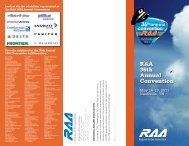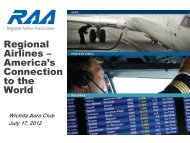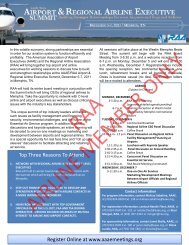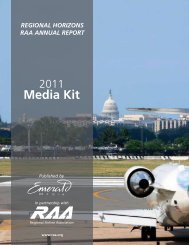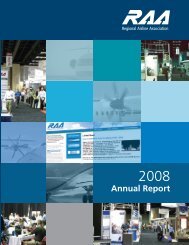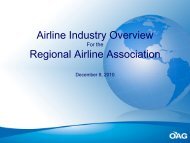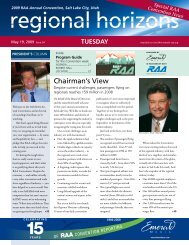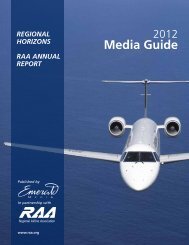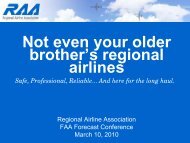Comments - Regional Airline Association
Comments - Regional Airline Association
Comments - Regional Airline Association
You also want an ePaper? Increase the reach of your titles
YUMPU automatically turns print PDFs into web optimized ePapers that Google loves.
more progressive development of content and features for both accessible and non-accessiblesites.Option 3A third option should be a primary carrier website that includes accessible tier two corefunctions. Accessible in this context should include incorporating any web accessibilitystandard. As discussed above, the tier two functions provide the most important information andfunctions to passengers with a disability. All of the benefits claimed in the PRA will be realizedwith a primary website that has tier two accessible features. This option is another measure theDepartment could adopt to avoid the SNPRM undue burden, impracticable tasking andunjustified costs.Option 4A fourth option should be a primary carrier website that incorporates any web accessibilitystandard, including WCAG 1.0, WCAG 2.0 Level A, or existing Section 508 standards intonewly created webpages starting two years from the final rule effective date. This option wouldprovide all of the benefits recognized in the PRA while giving carriers flexibility and avoidingsome costs. In addition, this option should include exemptions for infrequently visited webpagesand exempt or allow alternatives for technologies that do not easily translate into text or otheraccessible formats, such as video or flash. Mandating this option alone would not reduce thecosts described in Section 5 of these comments and would result in the overall costs stillexceeding the benefits creating an undue burden for carriers. A mandate for only this optionwould also discourage or prevent additional technology advances from developing andbenefitting all passengers.C. DOT Should Enforce Requirements Directly Against Ticket AgentsThe Department should not adopt its proposal to require carriers to enforce the websiteaccessibility requirements against ticket agents. Carriers will have no leverage to enforce DOTregulations. If the Department is interested in regulating ticket agent websites, it should do sodirectly and not through carriers. Indirect regulation of ticket agents will cause conflicts incontractual relationships, slow implementation, and create another layer of bureaucracy that doesnot benefit consumers. We estimate it would cost a minimum of $250,000 per year per carrier to“enforce” accessibility requirements against ticket agents. 27 Carrier efforts to identify and notifya ticket agent of web accessibility shortcomings will not ultimately result in compliance. Carriersare not regulators and should not be burdened with this regulatory function.27 This cost is based on the need to have several dedicated personnel or hiring contractors to work with ticket agentsto ensure compliance. Given the potential fines for non-compliance, simply changing contractual terms with a ticketagent, without resources to ensure compliance would not be a valid option.14






